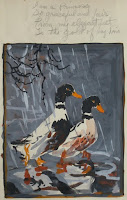The T Eaton Company
 As with her other works, we have a lot of preliminary sketches as well as finished illustrations. Among Bertha's pencil sketches is a very rough Eaton's Catalogue cover design for the Golden Jubilee Anniversary edition of Fall-Winter 1919 - 1920. We don't know the circumstances surrounding it, but we do know that the Ingle family had several connections with the T Eaton Company, and perhaps directly to the Eaton family, as well.
As with her other works, we have a lot of preliminary sketches as well as finished illustrations. Among Bertha's pencil sketches is a very rough Eaton's Catalogue cover design for the Golden Jubilee Anniversary edition of Fall-Winter 1919 - 1920. We don't know the circumstances surrounding it, but we do know that the Ingle family had several connections with the T Eaton Company, and perhaps directly to the Eaton family, as well.
Bertha's sisters Ethel and Kate both worked in the Eaton's department store starting in about 1902. That store was Kate's place of employment for several years, and she met her future husband there, E Stanley Lindabury (our grandfather), a Department Manager. Bertha's mother, Mary, may also have worked at Eaton's as a garment worker when she first arrived in Toronto.
As mentioned in an earlier posting (A Private View), Bertha very likely knew Emma Scott Raff in Owen Sound, in the 1890s. It was Timothy Eaton who, at the urging of his wife Margaret (a close friend and admirer of Emma), funded the original construction of Emma's Greek Temple, the Margaret Eaton School of Literature and Expression, where Bertha held her private exhibition in 1906. Emma's husband, George Gallie Nasmith, whom Bertha likely knew well, published a biography of Timothy Eaton in 1923. So, as my sister puts it, the T. Eaton Company was in a sense 'the family firm' for the Ingles.
Around the turn of the century, the Eaton's mail-order catalogue was already a Canadian institution, and in fact it remained so well into the latter half of the twentieth century. I began to look at the old Eaton's Catalogues on-line in the hopes of finding out whether Bertha's cover design sketch for the Golden Jubilee had ever been used. So far, it appears that it was not, but I discovered something else of equal interest.
Around the turn of the century, the Eaton's mail-order catalogue was already a Canadian institution, and in fact it remained so well into the latter half of the twentieth century. I began to look at the old Eaton's Catalogues on-line in the hopes of finding out whether Bertha's cover design sketch for the Golden Jubilee had ever been used. So far, it appears that it was not, but I discovered something else of equal interest.
 |
| Excerpt from Eaton's 1916 Spring and Summer Catalogue |
I realized (only quite recently) that Bertha did some illustrations that are are of exactly the type and style that appeared in the Eaton's catalogues:
They are rather better than average, in my opinion. We don't know whether they were ever published in an Eaton's catalogue (or anywhere else), but they might well have been. So here's a challenge for someone: go through as many of the old catalogues as can be found, and see if any of Bertha's 'faces' can be found. I may offer a small cash prize.
The 1919 and 1921 Toronto City Directories list Bertha as being employed by James E Laughlin, whose workshop or studio was in the downtown Arcade Building, a then-fashionable four-storey shopping centre that stretched between Yonge Street and Victoria Street, just south of Queen Street. The Directories tell us there were at least two other women artists employed by James E Laughlin there. We don't know what their work was, and we'd love to find out more about it.
James Everett Laughlin was an illustrator whose efforts, as my sister has discovered, can be seen on-line in the ebook version of Lieutenant-Governors of Upper Canada and Ontario 1792 - 1899, by D B Read, QC. Laughlin illustrated that book with full-page portraits of 22 of the subjects.
Upon examining the book, my sister realized that the style of Laughlin's Lieutenant-Governor illustrations bears a certain resemblance to that of the Eaton's Catalogue illustrations. She wondered if the James E Laughlin workshop might conceivably have had contracts to do commercial artwork for Eaton's, and that Bertha might have been hired on for that purpose, around 1919 or perhaps shortly before. Perhaps she did the 'faces' shown above while working for Laughlin. It's purely speculation, at this stage, but not such a far-fetched notion.
By contrast, we can be completely certain about Bertha's role in another publishing arena. Especially close to Bertha's heart, as subjects in illustration as well as in portraiture, were children. She loved to make images of children, and to create images that children would enjoy. Both these interests were served in the work she did for the Canadian Red Cross Junior magazine, in a long association that lasted from 1922 to 1949. We have many of the magazines themselves, as well as sketches and finished 'original' pieces.
There is always great charm and a high level of artistry in even the simplest of Bertha's works as an illustrator. We may never frame very many of them and hang them on walls, but they are treasures, nonetheless, and we are delighted to have them.
















No comments:
Post a Comment